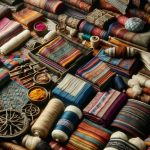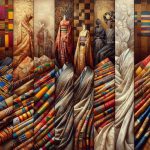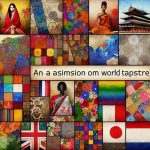When you think about traditional fabrics, you're not just considering the materials themselves but the rich histories and cultural narratives they embody. Imagine the intricate patterns of Indonesian Batik or the vibrant colors of Ghanaian Kente Cloth, each with symbolic meanings and craftsmanship passed down through generations. Indian Silk Saris and Japanese Kimono fabrics aren't merely garments; they're expressions of heritage and artistry. And there's so much more to uncover about Scottish Tartans, Guatemalan Huipil textiles, and Moroccan Berber weavings. What stories do these fabrics tell, and how do they continue to shape identities today?
Table of Contents
Key Takeaways
- Traditional fabrics like Indonesian Batik and Ghanaian Kente Cloth symbolize cultural heritage and social identity through intricate designs and vibrant colors.
- Techniques such as wax resist in Batik and backstrap loom weaving in Guatemalan Huipil textiles highlight artisans' dedication and craftsmanship.
- Each fabric type, like Indian Silk Saris or Japanese Kimono fabrics, showcases unique regional weaving and dyeing techniques.
- Cultural symbols, such as motifs in Japanese fabrics or clan patterns in Scottish Tartans, convey deep-seated traditions and histories.
- Moroccan Berber weavings and other heritage fabrics often involve months of meticulous work, preserving ancient practices and storytelling through patterns and colors.
Batik of Indonesia
Batik from Indonesia showcases intricate designs and vibrant colors, reflecting the country's rich cultural heritage. You'll find that batik isn't just a fabric but a canvas where artisans bring centuries-old traditions to life.
The magic of batik lies in the wax resist technique, where wax is meticulously applied to the fabric to create patterns. Once the wax hardens, the cloth is dyed, and the waxed areas resist the dye, preserving the original color beneath.
Mastering the craft requires patience and an eye for detail, as each layer of wax and dye builds upon the previous one, resulting in complex, multi-colored patterns that are nothing short of breathtaking. These designs often carry deep cultural significance, representing anything from local folklore to religious symbolism.
By learning and appreciating the art of batik, you're not just acquiring a skill but also connecting with a piece of Indonesia's cultural heritage.
Understanding batik means recognizing the dedication and artistry that go into every piece. As you explore this intricate craft, you'll appreciate the blend of tradition and creativity that defines Indonesian batik, making it a timeless and treasured art form.
Kente Cloth of Ghana
When you explore Kente Cloth of Ghana, you'll uncover its rich historical significance and origins linked to the Ashanti people.
Each pattern and color holds deep symbolism, conveying stories and messages.
Today, Kente has found its way into modern fashion, showcasing its adaptability and enduring appeal.
Historical Significance and Origin
You can trace the roots of Kente cloth back to the Ashanti Kingdom in Ghana, where it was originally woven for royalty and ceremonial occasions. This fabric isn't just about its vibrant colors and intricate patterns; it symbolizes cultural importance and heritage.
The weaving of Kente cloth involves ancient techniques passed down through generations, each thread holding a piece of history. As you explore further, you'll discover that the fabric represents social status, ethical values, and spiritual beliefs.
Mastery of Kente weaving requires understanding its historical context. The Ashanti weavers developed their skills by observing the natural world, translating the beauty of their environment into complex designs. They used traditional looms and materials such as silk and cotton, blending them to create a fabric that was both durable and visually stunning.
Over time, Kente cloth became a symbol of unity and identity among the Ashanti people.
Patterns and Symbolism
Each pattern in Kente cloth carries profound meanings, reflecting the values, history, and beliefs of the Ashanti people. You'll find that the cultural significance of Kente cloth lies in its intricate design variations and the rich symbolism imbued in its colors and patterns. Every thread and motif speaks to a specific aspect of Ashanti culture, from proverbs to historical events and philosophical concepts.
Understanding Kente cloth requires an in-depth exploration into its color symbolism and traditional motifs. Here's a brief overview:
| Color | Symbolism |
|---|---|
| Black | Maturity, spiritual energy |
| Blue | Peace, love, harmony |
| Green | Growth, renewal, fertility |
| Gold | Royalty, wealth, high status |
| Pattern | Meaning |
| Zigzag Lines | Complexity of life |
| Squares | Unity, harmony |
| Spiral Designs | Initiative, dynamism |
| Crosshatch | Skillfulness, craftsmanship |
As you explore Kente, you'll appreciate how design variations offer a visual language that conveys profound messages. The traditional motifs are not merely decorative; they encapsulate the Ashanti's collective wisdom and social values. Each piece of Kente cloth is a tribute to the weaver's skill and the cultural heritage it represents.
Modern Usage and Adaptations
While preserving its rich traditions, Kente cloth has adapted to modern trends and found new roles in contemporary fashion and global culture. You can see this fabric's vibrant patterns gracing runways, streetwear, and even high-end designer collections. By embracing innovative designs, Kente cloth seamlessly blends the old and new, making it a versatile choice for various fashion statements.
You'll notice that designers today aren't just sticking to traditional patterns; they're experimenting with new motifs and color combinations. This evolution breathes fresh life into Kente cloth, resonating with younger, trend-savvy audiences while still honoring its heritage. It's a fascinating blend of history and modernity, perfect for those who appreciate both.
In the realm of sustainable fashion, Kente cloth stands out. Its production methods are often eco-friendly, utilizing natural dyes and hand-weaving techniques that have minimal environmental impact. By choosing Kente, you're not just wearing a piece of fabric; you're supporting a tradition that values sustainability and craftsmanship. This makes Kente an excellent choice for those who prioritize ethical fashion without compromising on style.
Integrating Kente cloth into your wardrobe means you're part of a movement that values both innovation and sustainability.
Indian Silk Saris
Often celebrated for their intricate designs and vibrant colors, Indian silk saris are a quintessential symbol of the country's rich textile heritage. You'll find that each region in India has its own unique silk weaving techniques, reflecting centuries of tradition and craftsmanship.
For example, the Banarasi sari from Varanasi is renowned for its elaborate brocades and fine silk, while the Kanjeevaram sari from Tamil Nadu is distinguished by its bold colors and heavy gold borders. These saris aren't just garments; they hold immense cultural significance, often worn during weddings, festivals, and other important ceremonies.
When exploring the vast array of Indian silk saris, you'll notice a stunning variety of color variations and traditional designs. From the deep, rich hues of a Patola sari to the pastel shades of a Chanderi silk, each piece tells a story of its own. Traditional motifs like peacocks, flowers, and intricate geometric patterns are woven meticulously, making each sari a work of art.
Mastering the appreciation of these exquisite pieces involves understanding the skill and dedication involved in their creation, making Indian silk saris not just attire, but a revered cultural artifact.
Japanese Kimono Fabrics
Japanese kimono fabrics, renowned for their exquisite beauty and intricate designs, offer a fascinating glimpse into the country's rich cultural heritage. The kimono design evolution reflects Japan's historical and cultural shifts, blending aesthetic appeal with profound cultural significance. As you explore these fabrics, you'll notice how traditional dyeing techniques, such as shibori and yuzen, showcase the craftsmanship excellence that has been passed down through generations.
One key aspect of kimono fabrics is the meticulous process involved in their creation. Master artisans spend years perfecting their skills, ensuring each piece is a work of art. The use of natural dyes from plants and minerals adds depth and vibrancy to the kimono, making each one unique.
Here's a quick overview of key elements in Japanese kimono fabrics:
| Aspect | Description | Importance |
|---|---|---|
| Kimono Design Evolution | Reflects historical and cultural shifts | Cultural significance |
| Traditional Dyeing Techniques | Shibori, Yuzen, and plant-based dyes | Craftsmanship excellence |
| Artisanship | Mastery of techniques over years | Unique, bespoke creations |
| Cultural Symbols | Motifs like cranes, cherry blossoms | Represents well-being and beauty |
| Fabric Types | Silk, crepe, and brocade | Varied textures and applications |
Scottish Tartan Patterns
Scottish tartan patterns, with their distinct crisscrossed designs, vividly represent the rich heritage and clan histories of Scotland. You'll find that each tartan tells a story, woven through generations, capturing the essence of Scottish identity.
The color meanings in tartans aren't arbitrary; they convey specific symbols and traditions. For instance, green often signifies the lush landscapes of the Highlands, while blue can represent Scotland's rivers and lochs. Red might be used to denote battles and the bloodshed of clan conflicts.
Regional variations in tartan patterns are equally fascinating. The Highlands and Lowlands each have unique designs, reflecting their diverse ecosystems and ways of life. Highland tartans tend to feature more bold and contrasting colors, suitable for the rugged terrain and dramatic weather conditions. Conversely, Lowland tartans often incorporate softer, more muted tones, mirroring the gentler landscapes of the region.
As you explore further into Scottish tartans, you'll appreciate how each pattern carries a legacy of familial pride and regional significance. Mastering the intricacies of these patterns not only enriches your understanding of Scottish culture but also connects you to a timeless tradition that continues to evolve.
Guatemalan Huipil Textiles
Just as Scottish tartans capture the essence of their heritage, Guatemalan huipil textiles vividly express the cultural identity and artistry of the indigenous communities. When you explore these vibrant designs, you're delving into a world where every hue and pattern tells a story.
The intricate motifs aren't mere decorations; they serve as symbols of cultural preservation, embodying the history and traditions passed down through generations.
You'll find that indigenous techniques play a crucial role in the creation of these textiles. Crafted on backstrap looms, each huipil showcases a weaver's textile artistry. The skill required to produce these garments is immense, often taking months to complete a single piece. The weavers use age-old methods, ensuring that the craftsmanship remains true to its roots.
As you study these textiles, appreciate not just their beauty but also the dedication involved in their creation. The commitment to maintaining these ancient practices is a tribute to the resilience and pride of the indigenous communities.
Moroccan Berber Weavings
When you encounter Moroccan Berber weavings, you're stepping into a rich tapestry of history and tradition that has been meticulously preserved through generations. These weavings are more than just textiles; they're an embodiment of tribal traditions and exceptional craftsmanship. Every pattern and color tells a story, revealing the weaver's connection to their ancestors and the land.
To truly appreciate Moroccan Berber weavings, you need to understand the cultural heritage that fuels this art. Each tribe employs distinct weaving techniques, passed down through countless generations. Whether it's the intricate knotting in a Beni Ourain rug or the vibrant colors of a Kilim, these techniques are a tribute to the weaver's skill and dedication.
As you explore further, you'll discover the symbolic meanings woven into these fabrics. Geometric shapes and natural dyes reflect the weaver's environment and experiences. The process isn't merely about creating a product; it's a spiritual and communal act, binding the past to the present.
Frequently Asked Questions
What Are the Cultural Significances of Traditional Fabrics in Different Societies?
Imagine vibrant patterns and rich textures. Traditional fabrics embody cultural heritage and societal identity. They tell stories, honor ancestors, and celebrate rituals. By understanding these fabrics, you gain deep insights into a society's soul and history.
How Have Traditional Fabrics Influenced Modern Fashion Trends?
You'll find that historical impacts and cultural heritage of traditional fabrics shape contemporary influences in fashion evolution. Designers draw inspiration from these fabrics, seamlessly blending them into modern trends, creating a rich tapestry of cultural continuity.
What Are Common Techniques Used in the Preservation of Traditional Fabrics?
You'll find preservation techniques that could move mountains, like natural dyeing to maintain colors and textile conservation methods to prevent decay. These strategies secure traditional fabrics survive for future generations, embodying both history and artistry.
How Do Climate and Geography Affect the Production of Traditional Fabrics?
Geographical influences shape the resources available for traditional fabrics, while climate impacts the fibers' quality and durability. You'll find that regional conditions dictate the techniques and materials artisans use in fabric production.
What Are Some Ethical Considerations in the Production of Traditional Fabrics?
When considering ethical production, you should focus on fair trade and sustainable practices. Guarantee workers are paid fairly and materials are sourced responsibly to protect the environment and maintain the integrity of traditional crafts.
- T-Shirt Fabric Price in Bangladesh for Bulk Manufacturing - June 21, 2025
- Price Guide: Good Knight Fabric Roll-On in Bangladesh - June 21, 2025
- A Look Into the Non-Woven Fabric Industry in Bangladesh - June 21, 2025







